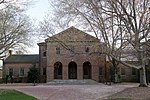College of William & Mary
The College of William & Mary (officially The College of William and Mary in Virginia, abbreviated as W&M) is a public research university in Williamsburg, Virginia. Founded in 1693 under a royal charter issued by King William III and Queen Mary II, it is the second-oldest institution of higher education in the United States and the ninth-oldest in the English-speaking world. It is classified among "R2: Doctoral Universities – High Research Activity". In his 1985 book Public Ivies: A Guide to America's Best Public Undergraduate Colleges and Universities, Richard Moll included William & Mary as one of the original eight "Public Ivies". The college educated American Presidents Thomas Jefferson, James Monroe, and John Tyler. It also educated other key figures pivotal to the development of the United States, including the first President of the Continental Congress Peyton Randolph, the first U.S. Attorney General Edmund Randolph, the fourth U.S. Supreme Court Chief Justice John Marshall, Speaker of the House of Representatives Henry Clay, Commanding General of the U.S. Army Winfield Scott, sixteen members of the Continental Congress, and four signers of the Declaration of Independence. Its connections with many Founding Fathers of the United States earned it the nickname "the Alma Mater of the Nation". George Washington received his surveyor's license from the college in 1749, and later became the college's first American chancellor in 1788. That position was long held by the bishops of London and archbishops of Canterbury, though in modern times has been held by U.S. Supreme Court justices, Cabinet secretaries, and British Prime Minister Margaret Thatcher. Benjamin Franklin received William & Mary's first honorary degree in 1756.William & Mary is notable for its many firsts in American higher education. The F.H.C. Society, founded in 1750, was the first collegiate fraternity in the United States, and W&M students founded the Phi Beta Kappa academic honor society in 1776, the first Greek-letter fraternity. In 1736, W&M became the first school of higher education in the future United States to install a student honor code of conduct. It is the only American university issued a coat of arms by the College of Arms in London. The establishment of graduate programs in law and medicine in 1779 makes it one of the first universities in the United States. The William & Mary Law School is the oldest law school in the United States, and the Wren Building, attributed to and named for the famed English architect Sir Christopher Wren, is the oldest academic building still standing in the United States.
Excerpt from the Wikipedia article College of William & Mary (License: CC BY-SA 3.0, Authors).College of William & Mary
Richmond Road, Williamsburg
Geographical coordinates (GPS) Address Nearby Places Show on map
Geographical coordinates (GPS)
| Latitude | Longitude |
|---|---|
| N 37.270833333333 ° | E -76.708333333333 ° |
Address
Lord Botetourt
Richmond Road
23185 Williamsburg
Virginia, United States
Open on Google Maps









